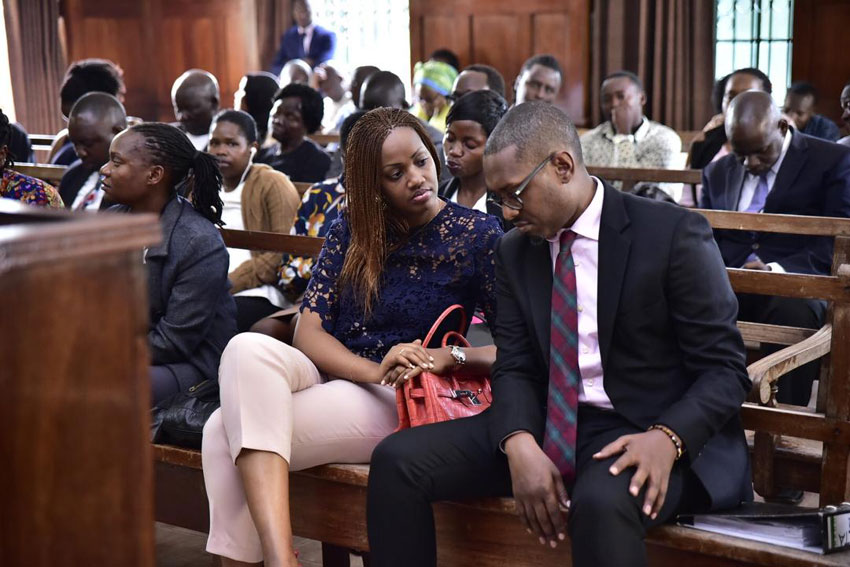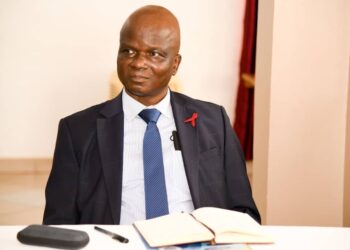The trial of Kampala businessman Matthew Kanyamunyu and his Burundian girlfriend Cynthia Munwangari resumed Tuesday in Kampala as a sixth witness took to the stand to testify that the late Kenneth Akena told him a wrong scene of crime in his dying declaration.
The sixth witness, John Paul Nyeko, a cousin to the late Kenneth Akena, revealed to court that Akena told him he had been shot after he scratched a car as he tried to park at Game stores in Lugogo.
“He said that they shot me from Game but not Kyadondo. He said that I was parking and, in the process, I brushed his car, which was parked, and when I went to them to apologize, the man pulled a pistol and shot me in the stomach.” Nyeko said.
“Game not Lugogo”, he told high court judge Steven Mubiru.
The witness had appeared before the criminal division of the High court to testify in a case in which businessman Kanyamunyu, his Burundian girlfriend Cynthia Munwangari and his brother Joseph Kanyamunyu are charged with the murder of Akena in November 2016.
Nyeko said the two (Akena and Nyeko) were meant to meet at Lugogo Rugby Grounds with another relative but he failed to show up until much later they received a call from Nakasero hospital informing them that Akena had been shot.
He said when they reached the hospital Matthew Kanyamunyu received them and introduced himself to them.
He sympathized with us and said he was around when his brother was shot at.
Nyeko said after doctors at Nakasero operated on Akena, they told them that ICU was full and he was referred to Norvik hospital from where he passed on.
Previously a witness told court presided over by Justice Steven Mubiru that when they did the postmortem examination on Akena’s body, they found – abandoned in the in the abdominal cavity – two surgical instruments and seven towels all soaked in blood. The items were left Inside Akena’s abdomen while he was still alive before stitching him up and transferring him to Norvik. Some analysts argue investigations should be opened to probe negligence on the part of doctors and the hospital which operated on the deceased.
Prosecution however alleges that Kanyamunyu was posing as a good Samaritan in taking Akena to hospital.
However, the discrepancy in the scene of crime as reported in the dying declaration vis a vis the actual scene as discovered by police, leaves prosecution case against Kanyamunyu in shambles as any inconsistency in a crucial issue such as the scene of crime, cannot be a minor matter.
The dying declaration was hitherto seen as the most major piece of evidence pinning Mr. Kanyamunyu but getting the scene of crime completely wrong in the declaration, is a fault in it that is difficult to ignore.
Police investigators have since identified Jinja Road near Malik Car Bond as the actual scene of crime, and a place Kanyamunyu said in his statement he picked Akena to take him to three hospitals on the uneventful night in efforts to save the child activist’s life.
Placing an assailant on the scene of crime in any criminal case, is a crucial factor in proving a case against the defendant. And getting the scene of crime wrong in a dying declaration raises a major question: if the victim was mistaken about the scene of crime, who is to say that he was not mistaken about the assailant too?
Mr Nyeko said his cousin mentioned “Game” not “Kyadondo”.
Investigators combed Game Shopping mall Parking Yard for a scene of crime and got nothing until they reached Kyadondo Rugby Grounds along Jinja Road which is mentioned in the indictment.
Focus on doctors
In the last court hearing, a witness told court that when they did the postmortem examination on Akena’s body, they found – abandoned in the in the abdominal cavity – two surgical instruments and seven towels all soaked in blood.
This provided a new twist pointing to criminal negligence on the part of the Doctors. Could doctors have mishandled Akena’s case, thus leading to his untimely death? If two forceps, medical clamps and seven mops left in one’s body are not potent enough in causing death, then what is?
Expert surgeon speaks out:
It was previously thought that the surgical instruments were abandoned in Akena’s abdomen after he died on the operating table but it has since come to the fore that the doctors who carried out the operation left the instruments in and stitched him up while still alive prior to transferring him to Norvik for more specialized handling.
The revelation of the medic as it was, had left many people wondering what could have happened to Akena.
An expert surgeon who preferred anonymity to speak freely on the matter told this investigative website that if it’s really true that foreign equipment was recovered from Akena’s body, then it was gross negligence on the part of the medical practitioners who did the operation on the deceased.
Even if it was a case of instruments being abandoned after the death of the victim which it was not, it would still be a matter of gross negligence. “Whenever we have a death in theatre; what we call a death on table (DOT), we continue as if it is normal surgery in that when the person dies on an operating table, we remove every instrument we were using. He adds, “Usually we have a white board where we write every instrument we have removed and then we match up what was there before the operation. This is a standard procedure during an operation.”
The surgeon said, “Then there are these things we call surgical mops [towels], we also count them and we remove them. So, if a procedure was going on and the patient passed away and you got a death on the table, of course surgery stops, everything is then removed from the patient, he/she is properly stitched back and we move back to other post operation procedures.”
He further noted that when an autopsy is conducted and foreign bodies apart from stitches are found in the patient’s body, it is absolute gross negligence and that puts questions as to the integrity of the whole procedure. whether this patient would have survived if proper procedure had been followed, becomes the operative question.
“It is not usual in medical practice for people conducting autopsies to find medical equipment…,” he concluded.
The revelations of the witness and the surgeon point to further interest in the real cause of Akena’s death and shade an inquisitive light into the sorry state of the country’s health care system which has turned many clinics and hospitals into veritable death-traps.
Do you have a story in your community or an opinion to share with us: Email us at editorial@watchdoguganda.com













